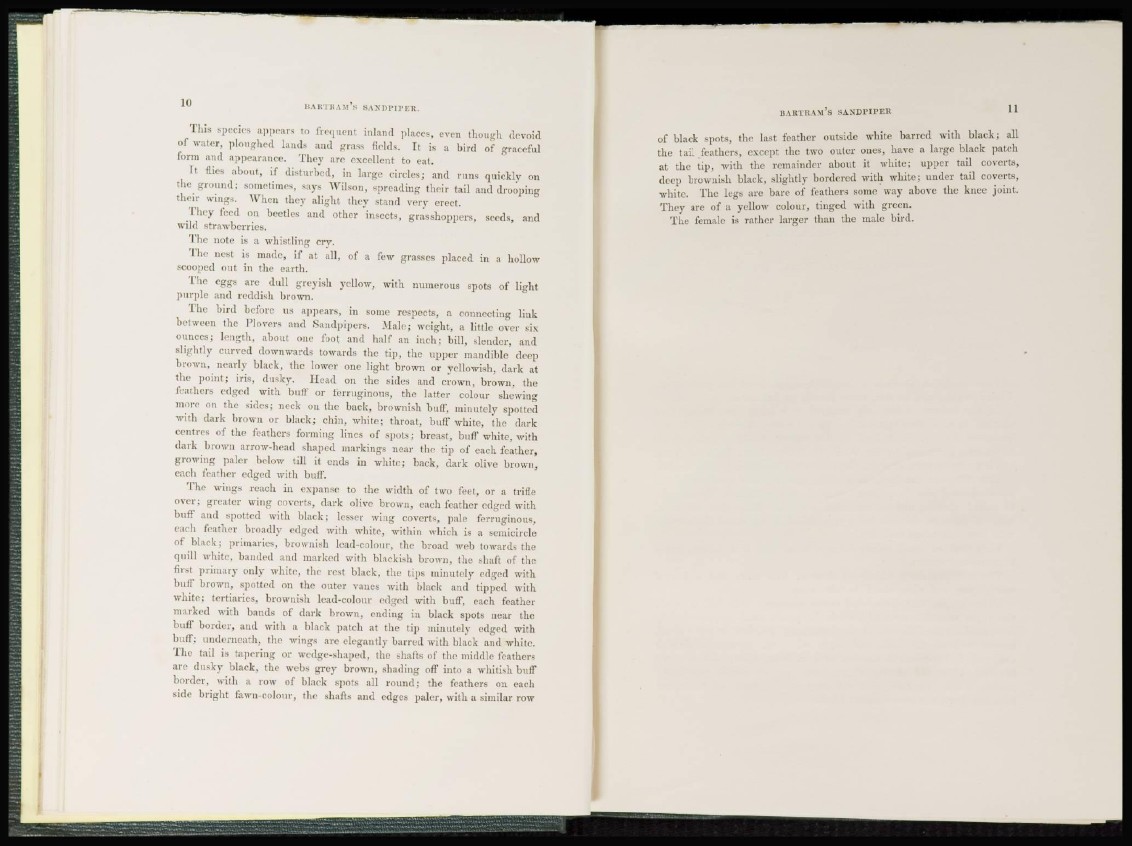
B \ RTHAM s SANDPIPER.
This species appears to frequent inland places, even though devoid
of water, ploughed lands and grass fields. It is a bird of graceful
form and appearance. They are excellent to eat.
\t flies about, if disturbed, in large circles; and runs quickly on
t h e g r o u n d ; sometimes, says "Wilson, spreading their tail and drooping
t h e i r wings. When they alight they stand very erect.
They feed on beetles and other insects, grasshoppers, seeds, and
wild strawberries.
The note is a whistling cry.
T h e nest is made, if at all, of a few grasses placed in a hollow
scooped out in the earth.
The eggs are dull greyish yellow, with numerous spots of light
p u r p l e and reddish brown.
The bird before us appears, in some respects, a connecting link
between the Plovers and Sandpipers, Male; weight, a little over six
ounces; length, about one foot and half an inch; bill, slender, and
s l i g h t ly curved downwards towards the tip, the upper mandible deep
brown, nearly black, the lower one light brown or yellowish, dark at
t h e point; iris, dusky. Head on the sides and crown, brown, the
feathers edged with buff or ferruginous, the latter colour shewing
more en the sides; neck on t h e back, brownish buff, minutely spotted
with dark brown or black; chin, white; throat, buif white, the dark
centres of t h e feathers forming lines of spots: breast, buff white, with
dark brown arrow-head shaped markings near the tip of each feather,
growing paler below till it ends in white; back, dark olive brown,
each feather edged with buif.
The wings reach in expanse to the width of two feet, or a trifle
over; greater wing coverts, d a r k olive brown, each feather edged with
buff and spotted with black; lesser wing coverts, pale ferruginous,
each feather broadly edged with white, within which is a semicircle
of black; primaries, brownish lead-colour, the broad web towards the
quill white, banded and marked with blackish brown, the shaft of the
first primary only white, t h e rest black, the tips minutely edged with
buff brown, spotted on the outer vanes with black and tipped with
w h i t e ; tertiaries, brownish lead-colour edged with buff, each feather
marked with bands of dark brown, ending in black spots near the
buff border, and with a black patch at the tip minutely edged with
buff; underneath, the wings are elegantly b a r r e d with black and white.
The tail is tapering or wedge-shaped, the shafts of the middle feathers
a r e dusky black, the webs grey brown, shading off into a whitish buff
b o r d e r , with a row of black spots all round; the feathers on each
side bright fawn-colour, the shafts and edges paler, with a similar row
BARTRAM'S SANDPIPER 11
of black spots, the last feather outside white barred with black; all
the tail feathers, except the two outer ones, have a large black patch
at the tip, with the remainder about it white; upper tail coverts,
deep brownish black, slightly bordered with white; under tail coverts,
white. The legs are bare of feathers some way above the knee joint.
They are of a yellow colour, tinged with green.
The female is rather larger than the male bird.